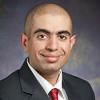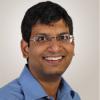Ring Amplifier and Its Emerging Applications
Ring Amplifier was first introduced at ISSCC in 2012. Significant advancements have been made since that time. A number of different implementations have enabled unprecedented efficiency in residue amplification of cascaded ADCs (e.g. pipeline/two-step). This presentation will start with the RingAmp basics and build from the core structure to cover various implementation examples as well as the latest developments on this topic.
 Un-Ku Moon received degrees from the University of Washington, Cornell University, and the University of Illinois at Urbana-Champaign. He has been with Oregon State University since 1998. Before joining Oregon State, he was with Bell Labs. He has served in various roles in the circuits community, including being the Editor-in-Chief of JSSC and TCAS-II. He currently serves as the Program Chair of 2020 ISSCC.
Un-Ku Moon received degrees from the University of Washington, Cornell University, and the University of Illinois at Urbana-Champaign. He has been with Oregon State University since 1998. Before joining Oregon State, he was with Bell Labs. He has served in various roles in the circuits community, including being the Editor-in-Chief of JSSC and TCAS-II. He currently serves as the Program Chair of 2020 ISSCC.
Applications and Special Features of Incremental ADCs
Sensor interfaces constitute a large segment of the electronics marketplace. Incremental ADCs play a key role in them, because they offer high accuracy, easy multiplexing, low latency, and simple digital filtering. Micro-power operation is also possible by implementing multi-step conversion. The lecture will cover the basic theory and describe a number of implemented ADCs.
 Gabor C. Temes held academic positions at the Technical University of Budapest, Stanford University, and the University of California, Los Angeles (UCLA). He worked in industry at Northern Electric R&D Laboratories, Ottawa, Canada, as well as at Ampex Corp. He is now a Distinguished Professor Emeritus of UCLA, and a Professor at Oregon State University. He received the IEEE Leon K. Kirchmayer Graduate Teaching Award in 1998, and the 2006 IEEE Gustav Robert Kirchhoff Award. He received the 2017 Semiconductor Industry Association - SRC University Researcher Award. He is a member of the National Academy of Engineering.
Gabor C. Temes held academic positions at the Technical University of Budapest, Stanford University, and the University of California, Los Angeles (UCLA). He worked in industry at Northern Electric R&D Laboratories, Ottawa, Canada, as well as at Ampex Corp. He is now a Distinguished Professor Emeritus of UCLA, and a Professor at Oregon State University. He received the IEEE Leon K. Kirchmayer Graduate Teaching Award in 1998, and the 2006 IEEE Gustav Robert Kirchhoff Award. He received the 2017 Semiconductor Industry Association - SRC University Researcher Award. He is a member of the National Academy of Engineering.
Energy Efficient Wireline Communication on Bandwidth Limited Channels
Energy/bit increases by 10x for every 30dB increase in channel loss. This trend is unsustainable for supporting high data rates of the future workloads. In the recent years efforts to achieve significant improvement in energy efficiency though technology scaling, circuit, architectural, and encoding innovations have been proposed. The presentation will introduce the basics of wireline communication including equalization, and demonstrate how new line and data coding schemes as an alternative to conventional equalization could be a disruptive force in wireline communication.
 Tejasvi Anand received his Ph.D. degree in Electrical Engineering from the University of Illinois at Urbana-Champaign and the M.Tech. degree (distinction) in Electronics Design and Technology from the Indian Institute of Science, Bangalore. From 2008 to 2010, he worked as an Analog Design Engineer at Cosmic Circuits (now Cadence), Bangalore. He joined Oregon State University in 2016. His research focuses on wireline communication, frequency synthesizers and energy harvesters with an emphasis on energy efficiency. He serves as a Technical Committee Member of Custom Integrated Circuits Conference (CICC).
Tejasvi Anand received his Ph.D. degree in Electrical Engineering from the University of Illinois at Urbana-Champaign and the M.Tech. degree (distinction) in Electronics Design and Technology from the Indian Institute of Science, Bangalore. From 2008 to 2010, he worked as an Analog Design Engineer at Cosmic Circuits (now Cadence), Bangalore. He joined Oregon State University in 2016. His research focuses on wireline communication, frequency synthesizers and energy harvesters with an emphasis on energy efficiency. He serves as a Technical Committee Member of Custom Integrated Circuits Conference (CICC).
Integrated mm-Wave Arrays: Architectures and Building Blocks
Millimeter-wave circuits and systems are expected to play a critical role for emerging 5G standards beyond 20GHz. This has led to extensive research and development in integrated phased-array transceivers that enable beamforming and beam steering at mm-wave. In this lecture, we will provide an overview of system-level tradeoffs based on phased-array architectures and building block specifications, followed by an introduction to the design of critical mm-wave phased-array building blocks in CMOS. The lecture will include examples from recent integrated array implementations.
 Arun S. Natarajan received the B.Tech. degree from the Indian Institute of Technology, Madras the M.S. and Ph.D. degrees from the California Institute of Technology. From 2007 to 2012, he was a Research Staff Member with IBM T. J. Watson Research Center and worked on mm-wave phased arrays for multi-Gb/s data links and airborne radar. He joined Oregon State University in 2012. His research is focused on RF, mm-wave and sub-mm-wave integrated circuits and systems for high-speed wireless communication and imaging. He has served on the Technical Program Committee of ISSCC, RFIC, CSICS and as an Associate Editor of the IEEE Transactions on VLSI Systems, and Guest Editor of the IEEE Journal of Solid-State Circuits. He is currently an Associate Editor of the IEEE Transactions on Microwave Theory and Techniques.
Arun S. Natarajan received the B.Tech. degree from the Indian Institute of Technology, Madras the M.S. and Ph.D. degrees from the California Institute of Technology. From 2007 to 2012, he was a Research Staff Member with IBM T. J. Watson Research Center and worked on mm-wave phased arrays for multi-Gb/s data links and airborne radar. He joined Oregon State University in 2012. His research is focused on RF, mm-wave and sub-mm-wave integrated circuits and systems for high-speed wireless communication and imaging. He has served on the Technical Program Committee of ISSCC, RFIC, CSICS and as an Associate Editor of the IEEE Transactions on VLSI Systems, and Guest Editor of the IEEE Journal of Solid-State Circuits. He is currently an Associate Editor of the IEEE Transactions on Microwave Theory and Techniques.


